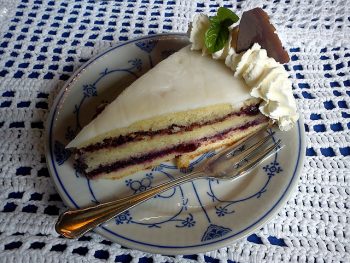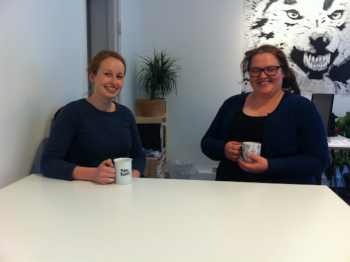Cake Parties in Southern Jutland Posted by Bjørn A. Bojesen on Jan 31, 2018 in Traditions
Sønderjylland – the southernmost part of Jutland – is known for its sønderjysk kaffebord (Southern Jutish ”coffee table”), a cake extravaganza made in heaven. I met two women with Sønderjylland roots, Ditte and Marie, for a talk about the unique tradition.
M: Back in the day when the Prussians took over Sønderjylland, the Danes used to gather around the kaffebord. And it became a tradition to gather in private homes and bring your own cakes.
D: They weren’t allowed to hold public meetings with alkohol consumption.
M: Then during WW2 it was resumed – again because people weren’t allowed to hold meetings. But is was okay to gather around kaffebordet, so that’s what people did, bringing at least one kage (cake). The tradition I know says that there should be at least 7 bløde (soft), 7 tørre (dry) and 7 hårde (hard) kager.
D: You often start with a bolle (bun) with a load of smør (butter) and a gærkringle (yeast pretzel). Then you proceed to the skærekager (hard cakes that are sliced with a knife), since they’re a bit dry and your mouth has already been ”wetted” with all the butter. Afterwards, it’s time for the lagkager (layer cakes). They’re supposed to be big and crazy like the brødtorte, which is made of Danish rugbrød (rye bread). Finally you go for the småkager (cookies), which you dip in kaffen (the coffee).
M: Traditionally you just cherrypicked from everything – so you needed to bring four tallerkner (plates) and a good gaffel (fork) in order to taste it all!
D: You had to taste it all. It was a way for husmødrene (the housewives) to show off their kitchen skills. It became a prestigeprojekt.
Where can a kaffebord be experienced today?
M: It’s kind of turned into a public event at places such as Gram Slot (Gram Castle), where all the old rules are followed. It has in a way become something extraordinary. When the bedstemødre (grandmothers) of our generation invited people over for søndagskaffe (Sunday coffee), it always included boller, skærekage, lagkage, småkager…
D: My grandmother celebrated her 90th birthday last year – and we were 14 persons. We had two layer cakes, two skærekager or tærter (tarts), a søsterkage (”sister cake”) and various kinds of småkager. So we still dish up with a lot of style! 🙂
Who does the baking?
D: In this case, my tanter (aunts) did.
M: I imagine it’s mostly the hosts. It’s hard to transport anything larger than småkager.
D: Since the tradition has moved from forsamlingshusene (public meeting houses) to private hjem [yemm] (homes), I also think that the individual hostess has been the chief baker.
So, before WW2 the kaffebord could also be at the forsamlingshus?
D: Yes. It all started around 1864 [when Denmark lost its southernmost part to Prussia]. People gathered in the forsamlingshus and they were not allowed to drink alcohol… Normally, a sønderjysk kaffebord concludes with a kaffepunch (coffee punch).
M: As I’ve heard the story, you put a mønt (coin) into a cup… You need som really strong coffee for this. You pour the coffee into the cup until you can no longer see the coin. Then you pour in snaps until the coin becomes visible again, and add some sugar to taste.
On which days does a kaffebord take place?
M: Traditionally the purpose was to meet and talk. Nowadays I think it’s mostly done in connection with familiesammenkomster (family gatherings).
D: Yes, all the small landsbyer (villages) used to have a sognegård (parish community centre) and a forsamlingshus – which was the place to meet people in a small community.
M: Later all the families in a particular town invited each other by turns, I think.
A kaffebord also has something to do with coffee, right?
D: Sure, huge amounts of coffee are always drunk by the guests – real coffee, that is. 🙂
In your opinion, what’s the best thing abut this tradition?
D: I think the best part is that you kind of have to taste a bit of everything. At other gatherings you’re expected to be restrained and showcase your modesty… But not at a sønderjysk kaffebord! 🙂
M: I remember a thing my late grandmother used to say… If you didn’t serve yourself a second time, she’d be like: ”Men kan du ikke li’ det?” (But don’t you like it?) It was a fornærmelse (insult) not to take a lot! 🙂

Build vocabulary, practice pronunciation, and more with Transparent Language Online. Available anytime, anywhere, on any device.





